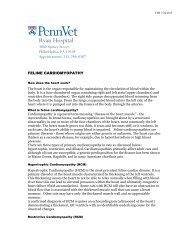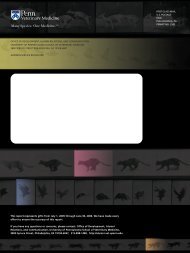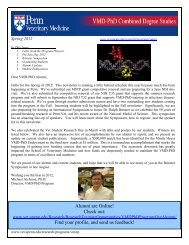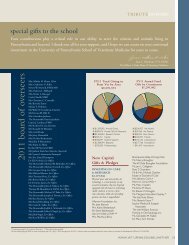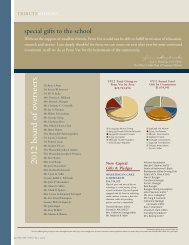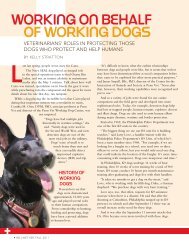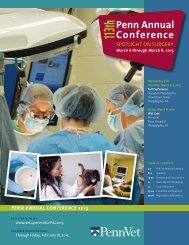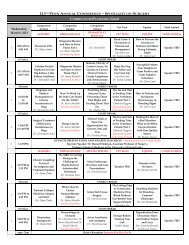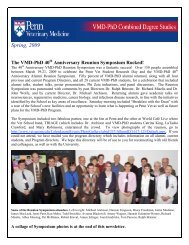March 2010 newsletter - University of Pennsylvania School of ...
March 2010 newsletter - University of Pennsylvania School of ...
March 2010 newsletter - University of Pennsylvania School of ...
You also want an ePaper? Increase the reach of your titles
YUMPU automatically turns print PDFs into web optimized ePapers that Google loves.
PENN VET RESEARCH MARCH <strong>2010</strong><br />
NEWSLETTER<br />
From dogs and cats to cows<br />
and chicken legs.......<br />
Bruce Freedman, an Associate<br />
Pr<strong>of</strong>essor in the Department <strong>of</strong><br />
Pathobiology, was born and raised<br />
in the farm country <strong>of</strong> Lancaster<br />
County. From a young age his<br />
ambition was to become a<br />
veterinarian. However, during the<br />
course <strong>of</strong> a senior honors biology<br />
research project at Dickinson<br />
College in Carlisle, PA, he started<br />
to explore a career in biomedical<br />
research and entered a Masters <strong>of</strong><br />
Science program at The<br />
<strong>Pennsylvania</strong> State <strong>University</strong><br />
under the guidance <strong>of</strong> Dr. Roland<br />
Leach. There he studied<br />
biochemical aspects <strong>of</strong> a cartilage<br />
abnormality called tibial<br />
dyschondroplasia in rapidly<br />
growing broiler chickens. This<br />
research experience prompted Dr.<br />
Freedman to revise his career<br />
plans and he applied to the NIH<br />
funded Veterinary Medical<br />
Scientist Training (VMSTP)<br />
program at Penn Vet. A<br />
photograph comparing the bones<br />
<strong>of</strong> normal and dysplastic chickens<br />
(Fig. 1) became a crucial part <strong>of</strong><br />
Dr. Freedman’s pitch for<br />
acceptance when he entered the<br />
VMSTP program in 1982. He<br />
completed his veterinary training<br />
in 1987, and his Ph.D. in<br />
Physiology in 1992.<br />
continued on page 2<br />
“Neither rain nor<br />
snow, nor sleet or dark<br />
<strong>of</strong> night”.......<br />
After a very snowy season,<br />
Penn Vet carries on. We look<br />
forward to our annual Phi Zeta<br />
Student Research Day on<br />
Thursday, <strong>March</strong> 25th.<br />
Students are busily planning<br />
their talks and poster<br />
presentations. This day is set<br />
aside to recognize and<br />
appreciate our student’s<br />
academic achievements. Our<br />
keynote speaker, Dr. Michael<br />
Blackwell, will help us think<br />
about the<br />
evolving role <strong>of</strong><br />
veterinary<br />
medicine today<br />
as we face the<br />
global issues <strong>of</strong><br />
public health,<br />
infectious<br />
disease,<br />
sustainable agriculture, and<br />
our ecosystem.<br />
“adapted "om Herodotus”<br />
PAGE 1
PENN VET RESEARCH MARCH <strong>2010</strong><br />
From dogs and cats to cows and chicken legs.. continued from page 1<br />
Figure 1. The normal chicken proximal tibiotarsus<br />
showing the epiphyseal growth plate and the articular<br />
cartilage (bottom). The epiphyseal plate appears as a<br />
thin layer <strong>of</strong> translucent cartilage with numerous<br />
capillary tunnels extending from the epiphyseal<br />
arteries. The metaphysis is characterized by numerous<br />
trabeculae separated by the metaphyseal vessels which<br />
ascend the shaft <strong>of</strong> the bone to the growth plate. A<br />
severe dyschondroplastic lesion in the proximal<br />
tibiotarsus (top). The lesion, an opaque cartilaginous<br />
mass, lies beneath the growth plate and displaces the<br />
spongy bone <strong>of</strong> the metaphysis. The trabeculae<br />
extending from the spongy bone appear normal in size<br />
but lack the parallel arrangement observed in the<br />
normal metaphysis.<br />
From Veterinary Medicine to<br />
Pathogen Signaling in<br />
Immune Cells - During the<br />
course <strong>of</strong> studies assessing<br />
calcium metabolism during bone<br />
growth, Dr. Freedman became<br />
interested in the role that this<br />
pathway played in regulating<br />
many cellular processes. Although<br />
he originally focused on calciummediated<br />
regulation <strong>of</strong> muscle<br />
function, he quickly became<br />
interested in the role <strong>of</strong> calcium<br />
and other ions in the regulation<br />
<strong>of</strong> immune cell function.<br />
Specifically his dissertation<br />
research focused on how these<br />
pathways controlled immunity to<br />
pathogens. During postdoctoral<br />
training in the Medical <strong>School</strong> at<br />
Penn under the supervision <strong>of</strong> Dr.<br />
Glen Gaulton, Dr. Freedman<br />
obtained funding to study the role<br />
<strong>of</strong> potassium channels in the<br />
development <strong>of</strong> a population <strong>of</strong><br />
lymphocytes, T cells, which<br />
provide long lived immunity to<br />
infection. He subsequently<br />
joined the laboratory <strong>of</strong> Dr.<br />
Michael Kotlik<strong>of</strong>f, former chair<br />
<strong>of</strong> Animal Biology, as a postdoctoral<br />
fellow. In that<br />
environment, Dr. Freedman’s<br />
work began to focus more closely<br />
on how calcium signaling<br />
regulated pathogen recognition<br />
and protective immune responses.<br />
Dr. Freedman believes that his<br />
veterinary medical training<br />
provided him with a unique<br />
background in comparative<br />
medicine that informs his<br />
research and <strong>of</strong>fers insights<br />
relevant to the treatment <strong>of</strong><br />
disease. The general objective <strong>of</strong><br />
his work is to understand how<br />
pathogen-induced signaling in<br />
lymphocytes and macrophages<br />
can be differentially regulated to<br />
elicit either a protective response<br />
or deleterious pro-inflammatory<br />
responses, depending on the<br />
specific context in which the<br />
pathogen is encountered. Most<br />
recently, he has focused on the<br />
role that intracellular calcium<br />
signaling plays in regulating<br />
functional responses to a variety<br />
<strong>of</strong> pathogenic stimuli. For<br />
example, he and his collaborator<br />
in the <strong>School</strong> <strong>of</strong> Medicine, Dr.<br />
Ron Collman, found that<br />
different strains <strong>of</strong> HIV-1, the<br />
causative agent <strong>of</strong> AIDS, elicit<br />
distinct signals within their target<br />
cells (lymphocytes and macrophages)<br />
that influences their<br />
ability to infect target cell types.<br />
In addition, Dr. Freedman’s group<br />
has also found that proteins<br />
derived from a wide range <strong>of</strong><br />
pathogens (including Ebola virus<br />
and a variety <strong>of</strong> pathogenic<br />
bacteria) elicit distinct signals<br />
within immune cells, affecting<br />
subsequent immune cell function.<br />
Dr. Freedman just received a five<br />
year NIH grant entitled “Diverse<br />
mechanisms <strong>of</strong> calcium signaling<br />
in B lymphocytes” to examine the<br />
mechanisms <strong>of</strong> pathogen-induced<br />
calcium signaling in B cells. The<br />
goal <strong>of</strong> these efforts is to visualize<br />
proteins directly involved in<br />
translating external stimuli into<br />
dynamic and functionally specific<br />
calcium signals. A cornerstone <strong>of</strong><br />
this approach has been the<br />
application <strong>of</strong> molecular<br />
approaches to modify the<br />
expression and function <strong>of</strong><br />
proteins involved in regulating<br />
calcium entry in B cells, in order<br />
to precisely define their role in<br />
signal transduction. In addition,<br />
Dr. Freedman uses techniques<br />
such as fluorescence resonance<br />
energy transfer (FRET) microscopy,<br />
that allow visualization<br />
and quantitative measurements <strong>of</strong><br />
the physical interactions between<br />
relevant signaling molecules and<br />
patch clamp recording to assay<br />
the activity <strong>of</strong> single calcium<br />
channels in immune cells.<br />
continued on page 4<br />
PAGE 2
PENN VET RESEARCH MARCH <strong>2010</strong><br />
VICE PROVOST’S SPECIAL SEMINAR<br />
On Monday, <strong>March</strong> 22, <strong>2010</strong> Penn Vet’s Neuroscience<br />
Center will co-host the Vice Provost’s Special<br />
Seminar in neuroscience in concert with the <strong>School</strong><br />
<strong>of</strong> Medicine Neuroscience Center, the Department<br />
<strong>of</strong> Genetics, Intellectual and Developmental<br />
Disabilities Research Center (IDDRC), and the<br />
Mahoney Institute <strong>of</strong> Neuroscience featuring a<br />
presentation by Eric J. Nestler, M.D., Ph.D.,<br />
Mount Sinai <strong>School</strong> <strong>of</strong> Medicine, director <strong>of</strong> the<br />
Mount Sinai Brain Institute and chair <strong>of</strong> the<br />
Department <strong>of</strong> Neuroscience. The title <strong>of</strong> his talk<br />
will be “Transcriptional and Epigenetic Mechanisms<br />
<strong>of</strong> Addiction”. The Special Seminar will be held in<br />
the BRB II/III auditorium at 4 pm with a reception<br />
to follow in the lobby. Contact Dr. Tracy Bale for<br />
more information (tbale@vet.upenn.edu). k<br />
Animal Research<br />
Information Electronic<br />
Submissions (ARIES) System<br />
The PennERA team (Electronic<br />
Research Administration) is<br />
providing optional orientation<br />
sessions available to researchers<br />
who create, review, or approve<br />
animal research protocols. These<br />
sessions will provide an overview <strong>of</strong><br />
the ARIES application, including<br />
navigation and other features.<br />
ARIES is the new secure, webbased<br />
lab animal protocol<br />
submission application that will<br />
provide the ability to electronically<br />
submit, track, and manage<br />
Institutional Animal Care and Use<br />
Committee (IACUC) protocol<br />
submissions.<br />
To register for a session, go to<br />
Knowledge Link at http://<br />
knowledgelink.upenn.edu/,<br />
authenticate with your PennKey<br />
and PennKey password, then click<br />
“Training - Optional” in the left<br />
toolbar. When the training list<br />
loads, scroll down to the course<br />
titled “ARIES - Animal Research<br />
Information Electronic Submissions<br />
Orientation Sessions –<br />
UNIV” and click “Enroll”. If you<br />
have any trouble accessing the<br />
course, contact<br />
aries_help@lists.upenn.edu.<br />
Germ Free Facility--Dr.<br />
David Artis Ph.D., Assistant<br />
Pr<strong>of</strong>essor, Department <strong>of</strong><br />
Pathobiology, has played a critical<br />
role in maintaining a germ-free<br />
mouse colony at Penn. Because <strong>of</strong><br />
the challenges in managing such<br />
colonies, there are very few<br />
universities that have germ-free<br />
facilities. Many years ago, Dr. John<br />
Cebra, developed a colony at Penn<br />
in the Department <strong>of</strong> Biology, and<br />
since Dr. Cebra’s death David has<br />
monitored the facility, and<br />
orchestrated the move <strong>of</strong> the<br />
colony from Biology to the Hill<br />
vivarium. This germ-free mouse<br />
colony is a unique resource for all <strong>of</strong><br />
the scientists at the <strong>University</strong> <strong>of</strong><br />
<strong>Pennsylvania</strong>.<br />
<br />
PAGE 3
PENN VET RESEARCH MARCH <strong>2010</strong><br />
Continued from page 2<br />
When combined with the ability<br />
to analyze signal transduction<br />
events within individual cells<br />
(using imaging techniques<br />
available in Dr. Freedman’s lab<br />
and the Core Imaging Facility in<br />
the Veterinary <strong>School</strong>), these<br />
cutting edge approaches will<br />
revolutionize the analysis <strong>of</strong><br />
calcium signaling in cells <strong>of</strong> the<br />
immune system.<br />
Finally, Dr. Freedman has<br />
combined high-resolution<br />
subcellular imaging with novel<br />
technical approaches to dissect<br />
the events that influence the<br />
duration <strong>of</strong> calcium signaling, a<br />
parameter known to influence<br />
gene expression patterns that<br />
dictate how immune cells respond<br />
to pathogen stimulation.<br />
Understanding these events would<br />
allow for the development <strong>of</strong><br />
therapeutic approaches to<br />
either modulate aberrant<br />
inflammation during autoimmunity<br />
or to amplify<br />
immune responses to invading<br />
microorganisms.<br />
Present and Future - The<br />
Veterinary <strong>School</strong> recently<br />
established a high end Core<br />
Imaging Facility. Dr.<br />
Freedman’s long term interest<br />
in employing advanced imaging<br />
techniques to visualize<br />
intracellular signaling responses<br />
to pathogens in single cells made<br />
him a natural choice to serve as<br />
Stimulated Resting<br />
director <strong>of</strong> this facility. Dr. and to expand a very productive<br />
Freedman’s interest in single cell collaboration initiated several<br />
imaging first took seed in the years ago with Dan Billadeau. The<br />
Kotlik<strong>of</strong>f lab and was developed focus <strong>of</strong> this combined effort is to<br />
further during the summer <strong>of</strong> understand signaling pathways<br />
1997, with funding from the that regulate lymphocyte motility<br />
Deutscher Akademischer critical for trafficking to sites <strong>of</strong><br />
Austausch Diens (DAAD, German inflammation where they become<br />
Academic Exchange Service) to<br />
work in the lab <strong>of</strong> Dr. Bernd<br />
activated by pathogens.<br />
Fleischmann at the <strong>University</strong> <strong>of</strong> Although Dr. Freedman has a<br />
Cologne, Germany. Dr.<br />
great affection for four legged<br />
Fleischmann’s group used high end companions, including his two<br />
single cell imaging and patch cats and a Chihuahua, he credits a<br />
clamp recording techniques to love <strong>of</strong> science and an affinity for<br />
study intracellular signaling in abstract problem solving as his<br />
cardiomyocytes and Dr. Freedman primary motivation for pursuing a<br />
adapted these techniques to his career in biomedical research and<br />
study <strong>of</strong> lymphocytes. This past veterinary medicine. Dr.<br />
year Dr. Freedman took a six Freedman’s laboratory is located<br />
month sabbatical at the Mayo on the 3<br />
Clinic in Rochester, MN. The goal<br />
<strong>of</strong> this sabbatical was to broaden<br />
the range <strong>of</strong> techniques in the lab<br />
rd floor <strong>of</strong> Old Vet<br />
Building, Suite 389E and his <strong>of</strong>fice<br />
is in Suite 368E. k<br />
STIMCFP ORAIYFP Wave2 STIM/ORAI STIM/WAVE ORAI/WAVE<br />
2.5 2.5!mm um<br />
2.5 2.5!mm um<br />
Pearson's correlation:<br />
Pearson's correlation:<br />
0.348 0.607 0.700<br />
0.727 0.239 0.272<br />
Figure 2. Primary B cells transfected with fluorescently-tagged molecules directly involved in calcium<br />
signaling (STIM1-CFP, Orai1-YFP), stimulated with thapsigargin to initiate their mobilization and<br />
interactions, then stained for the actin cytoskeletal regulator WAVE2 to determine if induced<br />
localization was required for their function. Protein localization was visualized in fixed specimens by<br />
confocal microscopy and colocalization analyzed using Volocity s<strong>of</strong>tware. Co-localization was assessed<br />
using Pearson’s correlation (higher correlation, greater degree <strong>of</strong> co-localization).<br />
PAGE 4
PENN VET RESEARCH MARCH <strong>2010</strong><br />
PHI ZETA STUDENT RESEARCH DAY <strong>2010</strong><br />
Thursday, <strong>March</strong> 25, <strong>2010</strong><br />
The annual Phi Zeta Student Research Day will be held on Thursday,<br />
<strong>March</strong> 25, <strong>2010</strong>. Participants may register online at:<br />
http://www.vet.upenn.edu/<br />
Keynote speaker, Dr. Michael Blackwell, is a former dean <strong>of</strong> the<br />
College <strong>of</strong> Veterinary Medicine, <strong>University</strong> <strong>of</strong> Tennessee. From 1999 to<br />
2000, he served as the Chief <strong>of</strong> Staff, Office <strong>of</strong> the Surgeon General.<br />
Prior to this Dr. Blackwell served for 20 years as an <strong>of</strong>ficial <strong>of</strong> the Food<br />
and Drug Administration (FDA). During his interim with the FDA, he<br />
covered major mission areas in both human and veterinary<br />
medicine Dr. Blackwell also had more than 15 years <strong>of</strong> experience as a<br />
veterinarian in private practice. This diverse background prepared him<br />
to assist with providing solutions to many <strong>of</strong> today’s public health<br />
challenges. From 1994 to 1998 he served as the chief veterinarian <strong>of</strong><br />
the United States Public Health Service (USPHS). In this role he was<br />
chief advisor to the Surgeon General <strong>of</strong> the United States.<br />
Academic awards will be given for oral presentations by students and<br />
Fisher Scientific ‘best poster’ prizes will be awarded.<br />
Organizers<br />
Those participating in organizing the day are Kathryn Michel, Michael<br />
Atchison, Margret Casal, John Lewis, Lisa Murphy, Nicola Mason,<br />
Phillip Scott, Dean Joan Hendricks, Ashra Markowitz, and Gayle<br />
Joseph. Student organizers are Jose Guevara, Ellison Aldrich, Brittany<br />
Gregory, Jeffrey Patterson-Fortin, Audra Pompeani Daniel Lantz, Anna<br />
Nomura, Haley Anderson, and Alexandra Cantelmo.<br />
Calendar<br />
Monday, <strong>March</strong> 22, <strong>2010</strong><br />
Vice Provost’s Special Seminar<br />
Eric Nestler, MD, PhD<br />
BRB II/III Auditorium 4 PM<br />
Thursday, <strong>March</strong> 25, <strong>2010</strong><br />
Phi Zeta-Student Research Day<br />
Hill Lobby 12 noon--6 PM<br />
Friday, June 18, <strong>2010</strong><br />
Annual Faculty Research Retreat at New<br />
New Bolton Center, Kennett Square.<br />
8:30 AM--5:30 PM<br />
S o m e Re c e n t Aw a rd s<br />
Michael Atchison<br />
RO1 AI079002<br />
Title: Control <strong>of</strong> B cell<br />
development by YY1.<br />
7/1/<strong>2010</strong>-6/30/2015<br />
$1,250,000<br />
Michael Atchison<br />
RO1 GM082841<br />
Title: Developmental control <strong>of</strong><br />
enhancer function.<br />
4/1/<strong>2010</strong> --3/31/2014<br />
$1,250,000<br />
James Ferguson<br />
Increasing Economic and Environmental<br />
Sustainability <strong>of</strong> Small and Medium<br />
Sized Dairy Farms<br />
USDA/NIFA<br />
1/1/<strong>2010</strong> - 12/31/2013<br />
$396,120<br />
Robert Whitlock,<br />
PA Johne’s Disease Demonstration Herd<br />
Penn State <strong>University</strong> (USDA)<br />
4/19/2009-3/31/<strong>2010</strong><br />
$15,000<br />
András Komáromy<br />
Achromatopsia - Disease mechanisms<br />
and cone-directed gene therapy<br />
ARRA Supplement to NIH grant<br />
EY-019304<br />
$84,236<br />
John Wolfe<br />
AAV vector gene transfer to manipulate the<br />
pontine micturition circuit. ARRA pilot grant<br />
for NIH 3P50DK052620-12S1 (Sam Chacko<br />
Prog. Dir)<br />
9/30/09 - 8/31/11 $119,796<br />
Kendra Bence<br />
Neuronal protein tyrosine phosphatases in<br />
metabolism. NIH/NIDDK ARRA supplement<br />
to R01 DK 082417.<br />
12/14/2009--2/28/<strong>2010</strong><br />
$99,928<br />
David Artis<br />
NIH R21 Epithelial cell regulation <strong>of</strong> intestinal<br />
immune homeostasis, 07/15/09-06/30/11,<br />
$275,000.<br />
PAGE 5
PENN VET RESEARCH MARCH <strong>2010</strong><br />
AGRICULTURAL SCIENCE<br />
In the summer <strong>of</strong> 2009, 12 Penn<br />
Vet students accompanied six<br />
faculty and staff members <strong>of</strong> the<br />
Center for Animal Health and<br />
Productivity (CAHP) on a trip to<br />
China to visit food animal<br />
production facilities as part <strong>of</strong><br />
their veterinary training. The trip<br />
was supported by the Hewlett<br />
Award for Innovation in International<br />
Offerings at Penn that<br />
was awarded to Dr. Zhengxia<br />
Dou, Associate Pr<strong>of</strong>essor in the<br />
Department <strong>of</strong> Clinical Studies,<br />
New Bolton Center. A USDA<br />
grant also provided support for the<br />
program.<br />
The two-week trip gave students a<br />
unique and eye-opening experience<br />
as they toured farms and learned<br />
food production basics. They<br />
visited research laboratories,<br />
attended seminars, and interacted<br />
with university faculty, students, as<br />
well as local residents. Guided by<br />
faculty from Penn and Chinese<br />
Universities, our students gained<br />
an appreciation <strong>of</strong> the Chinese<br />
systems <strong>of</strong> animal nutrition,<br />
management, and economics and<br />
their effects on farm productivity<br />
and the environment. They also<br />
learned that veterinary medicine<br />
involves more<br />
than just diagnosis<br />
and treatment <strong>of</strong><br />
sick animals and<br />
that future veterinarians<br />
must have<br />
the necessary<br />
knowledge and<br />
preparation to<br />
play a larger role<br />
in the changing<br />
world <strong>of</strong><br />
globalization <strong>of</strong><br />
food production.<br />
A new Hewlett Award has been<br />
granted to Dr. Dou, which will<br />
support yet another group <strong>of</strong> Penn<br />
Vet students to travel to China this<br />
summer. The new award will help<br />
to establish a long-term<br />
partnership in research and<br />
education with Chinese institutions.<br />
Such international,<br />
interdisciplinary collaborations<br />
will promote a new educational<br />
paradigm for Penn Vet’s<br />
involvement in global issues <strong>of</strong><br />
sustainable food animal<br />
production, environmental<br />
protection, and veterinary public<br />
health. k<br />
Some recent papers<br />
NEMO-binding<br />
domains <strong>of</strong> both<br />
IKKalpha and IKKbeta<br />
regulate IkappaB kinase<br />
complex assembly and<br />
classical NF-kappaB<br />
activation. Solt LA,<br />
Madge LA, May MJ.<br />
J Biol Chem. 2009 Oct 2;284(40):27596-608<br />
Insights into Serotonin<br />
Signaling Mechanisms<br />
Associated with Canine<br />
Degenerative Mitral<br />
Valve Disease.<br />
Oyama MA, Levy RJ.<br />
J Vet Intern Med.<br />
<strong>2010</strong>;24:27-36.<br />
Gene therapy in large animal models <strong>of</strong><br />
human cardiovascular genetic disease.<br />
Sleeper MM, Bish LT,<br />
Sweeney HL. Inst. Lab<br />
Animal Res J. 50(2):<br />
199-205. 2009<br />
Identification <strong>of</strong> the nuclear receptor <br />
DAF‐12 as a therapeutic target in parasitic <br />
nematodes.Wang Z, Zhou XE, Motola DL,<br />
Gao X, Suino-Powell K,<br />
Conneely A, Ogata C,<br />
Sharma KK, Auchus RJ,<br />
Lok JB, Hawdon JM,<br />
Kliewer SA, Xu HE,<br />
Mangelsdorf DJ. Proc<br />
Natl Acad Sci U S A.<br />
2009 Jun 9;106(23):<br />
9138-43.<br />
Special Seminar<br />
Thursday, April 29, <strong>2010</strong> - 3 PM<br />
Department <strong>of</strong> Physiology presents:<br />
Dr. Toni Scarpa, director <strong>of</strong> the<br />
Center for Scientific Review<br />
(NIH) DHHS<br />
“Challenges & Opportunities in Peer<br />
Review: A Vision for Ensuring its Strategic<br />
National Value”<br />
Dunlop Auditorium, Stemmler Hall<br />
RSVP by April 22 to<br />
phys@ail.med.upenn.edu<br />
PAGE 6
PENN VET RESEARCH MARCH <strong>2010</strong><br />
O N E M E D I C I N E<br />
Penn Vet pr<strong>of</strong>essor Gustavo Aguirre (Clinical<br />
Studies PHL) recently spent two weeks traveling to<br />
cities throughout Spain presenting lectures to visionimpaired<br />
patients. He updated them on the various<br />
research treatment avenues currently being explored<br />
and indicated how such treatments might ultimately<br />
be translated into therapeutic approaches for their<br />
hereditary eye diseases. Concerned patients in<br />
Pamplona and Madrid were informed <strong>of</strong> progress in<br />
the field <strong>of</strong> retinal degeneration by Dr. Elena Vecino,<br />
a Pr<strong>of</strong>essor <strong>of</strong> Cell Biology at the <strong>University</strong> <strong>of</strong> the<br />
Basque Country and Dr. Aguirre. Dr. Aguirre has<br />
been giving these updates annually for the last five<br />
years and has developed a considerable rapport with<br />
these groups. Dr. Aguirre’s sensitivity to the needs <strong>of</strong><br />
visually impaired patients is exemplified by his<br />
attention to detail. In particular, persons with low<br />
vision can differentiate Power Point presentations<br />
best on a blue background, so Dr. Aguirre always<br />
presents slides with yellow print on a blue backdrop.<br />
This obvious concern, coupled with his clear<br />
Would you like to:<br />
• Learn more about using EndNote or RefWorks<br />
with the Libraries databases?<br />
• Run literature searches in any <strong>of</strong> the databases?<br />
• Learn some <strong>of</strong> PubMed’s power searching<br />
features?<br />
• Set-up searches that automatically run on your<br />
topic each week?<br />
• Find that elusive full-text article?<br />
explanations <strong>of</strong> ongoing research in Spanish, has<br />
endeared Dr. Aguirre to these organizations, and they<br />
eagerly await his visits. In addition, Dr. Aguirre<br />
presented a research seminar on developing therapies<br />
for retinal degenerations at the Center for Biological<br />
Investigations (CIB) in Madrid, as well as a second<br />
<strong>University</strong>-wide research seminar on retinal gene<br />
therapy at the Bi<strong>of</strong>oro, <strong>University</strong> <strong>of</strong> the Basque<br />
Country. Dr. Aguirre sustains the long history and<br />
importance <strong>of</strong> translational research at Penn Vet.<br />
David Artis, PhD, Assistant Pr<strong>of</strong>essor in the Department <strong>of</strong> Pathobiology, has<br />
authored a newly published paper in Nature that defines a previously<br />
unidentified stem cell-like population that promotes immune responses in the<br />
intestine. The findings <strong>of</strong> the paper have broad implications, as Th2 cells are<br />
not only critical for controlling helminth infections, but also promote unwanted<br />
immune responses associated with asthma and allergies.<br />
IL25 elicits a multipotent progenitor cell population that promotes TH2<br />
cytokine responses. SA Saenz, MC Siracusa, JG Perrigoue, SP Spencer, JF Urban Jr,<br />
JE Tocker, AL Budelsky, MA Kleinschek, T Kambayashi, A Bhandoola, & D. Artis.<br />
(<strong>2010</strong>) NATURE, in press, Advance Online Publication on www.nature.com/nature<br />
The Steven W. Atwood Library & Information Commons<br />
To discuss library resources<br />
or service topic, just send<br />
an email to:<br />
campbell@pobox.upenn.edu.<br />
Margaret Grasberger<br />
Lindem will begin work on Monday, <strong>March</strong> 8, as the<br />
new head <strong>of</strong> the veterinary libraries.<br />
http://www.library.upenn.edu/vet/<br />
PAGE 7
PENN VET RESEARCH MARCH <strong>2010</strong><br />
Penn Vet Imaging Facility...online scheduling<br />
Penn Vet’s Imaging Facility is<br />
located on the third floor <strong>of</strong> the<br />
Hill Pavilion. The core houses a<br />
four laser, two-photon/c<strong>of</strong>ocal laser<br />
scanning spectral imaging Leica<br />
SP5 system on a DM6000<br />
microscope and a two laser<br />
Yokagawa CSX-1 spinning disk<br />
confocal configured with a Leica<br />
DMI4000 microscope. These<br />
<strong>University</strong> <strong>of</strong> <strong>Pennsylvania</strong> <strong>School</strong> <strong>of</strong> Veterinary Medicine<br />
380 S <strong>University</strong> Avenue, Suite 310B Hill Pavilion<br />
Philadelphia, PA 19104-4539<br />
Bipolar cell labeling in a canine retina<br />
William Beltran Laboratory<br />
instruments will provide capability<br />
for fixed specimen, in vivo and live<br />
cell optical micro-imaging. To<br />
inquire about this core facility,<br />
please contact Dr. LingLi Zhang at<br />
215 746-0471 or the Department <strong>of</strong><br />
Pathobiology at 215 746-2046. An<br />
online scheduler for the Nikon-<br />
E600 wide filed fluorescence<br />
microscope has been posted. In<br />
the electronic version <strong>of</strong> this<br />
<strong>newsletter</strong> you may follow this link:<br />
Scheduler for the Nikon and for<br />
the confocal use this link: confocal<br />
scheduler.<br />
TO:<br />
The Penn Vet Research<br />
Newsletter is distributed<br />
quarterly: suggestions,<br />
requests, comments, and<br />
story ideas should be sent<br />
directly to:<br />
resnews@vet.upenn.edu<br />
Office <strong>of</strong> the<br />
Associate Dean for Research<br />
Phillip Scott, Ph.D.<br />
<strong>University</strong> <strong>of</strong> <strong>Pennsylvania</strong> <strong>School</strong> <strong>of</strong><br />
Veterinary Medicine<br />
310B Hill Pavilion<br />
380 S <strong>University</strong> Avenue<br />
Philadelphia PA 19104-4539<br />
http://www.vet.upenn.edu/



